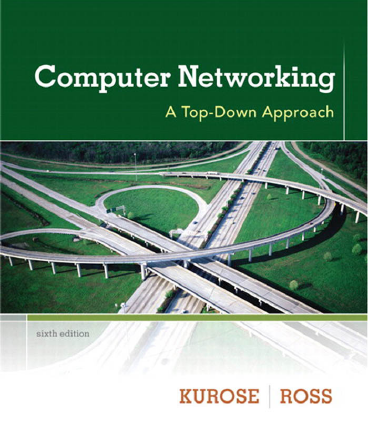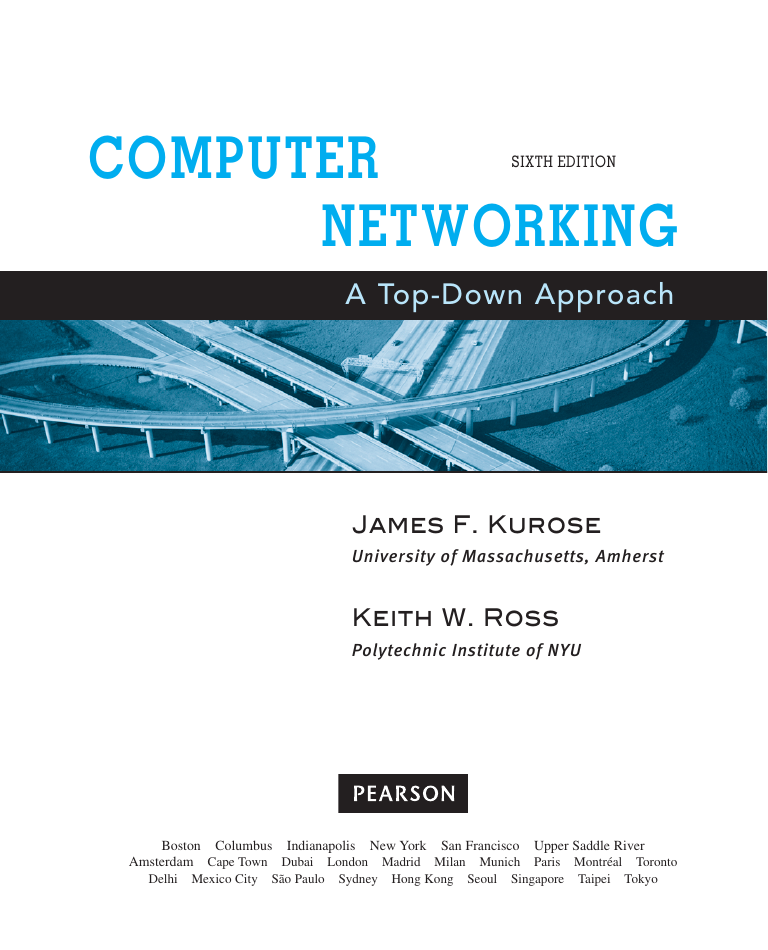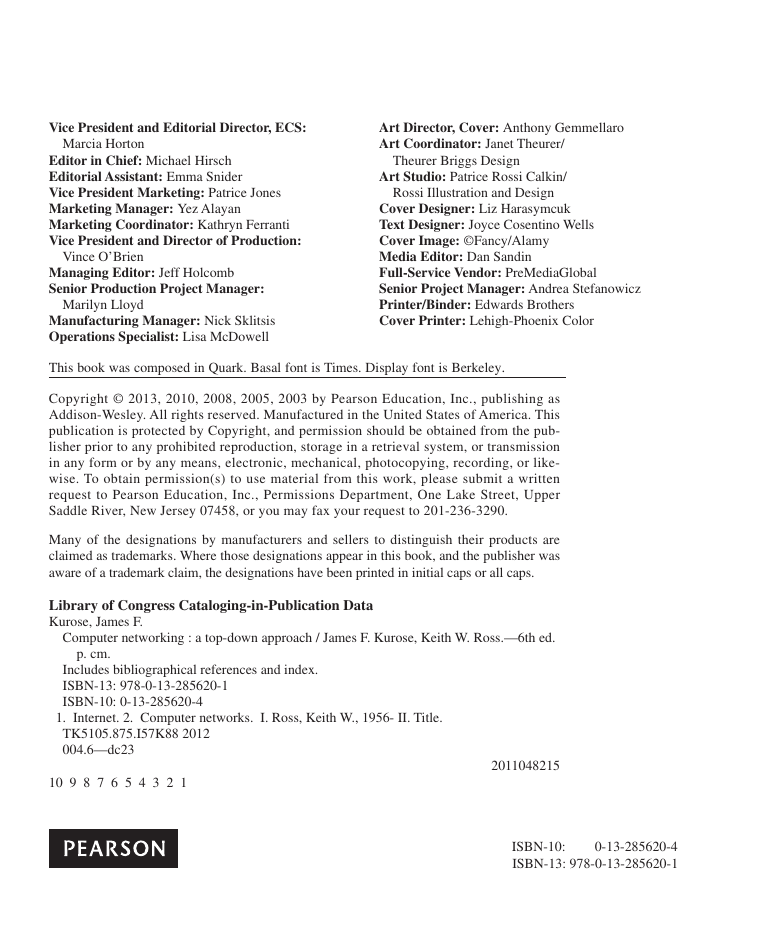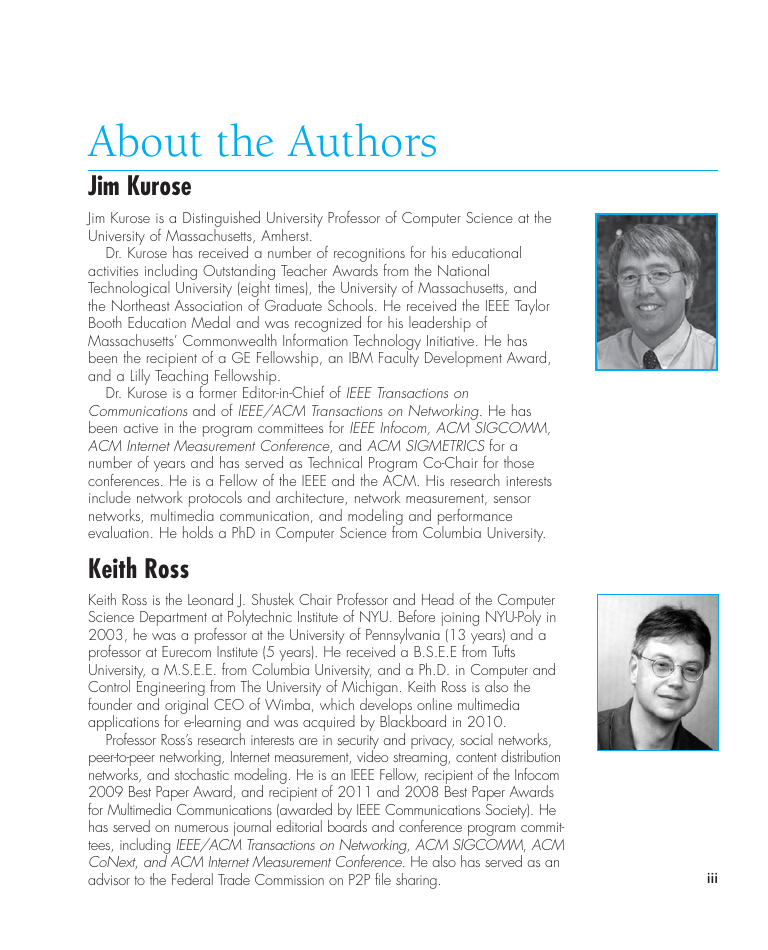Cover
Title Page
Copyright Page
Table of Contents
Chapter 1 Computer Networks and the Internet
1.1 What Is the Internet?
1.1.1 A Nuts-and-Bolts Description
1.1.2 A Services Description
1.1.3 What Is a Protocol?
1.2 The Network Edge
1.2.1 Access Networks
1.2.2 Physical Media
1.3 The Network Core
1.3.1 Packet Switching
1.3.2 Circuit Switching
1.3.3 A Network of Networks
1.4 Delay, Loss, and Throughput in Packet-Switched Networks
1.4.1 Overview of Delay in Packet-Switched Networks
1.4.2 Queuing Delay and Packet Loss
1.4.3 End-to-End Delay
1.4.4 Throughput in Computer Networks
1.5 Protocol Layers and Their Service Models
1.5.1 Layered Architecture
1.5.2 Encapsulation
1.6 Networks Under Attack
1.7 History of Computer Networking and the Internet
1.7.1 The Development of Packet Switching: 1961–1972
1.7.2 Proprietary Networks and Internetworking: 1972–1980
1.7.3 A Proliferation of Networks: 1980–1990
1.7.4 The Internet Explosion: The 1990s
1.7.5 The New Millennium
1.8 Summary
Homework Problems and Questions
Wireshark Lab
Interview: Leonard Kleinrock
Chapter 2 Application Layer
2.1 Principles of Network Applications
2.1.1 Network Application Architectures
2.1.2 Processes Communicating
2.1.3 Transport Services Available to Applications
2.1.4 Transport Services Provided by the Internet
2.1.5 Application-Layer Protocols
2.1.6 Network Applications Covered in This Book
2.2 The Web and HTTP
2.2.1 Overview of HTTP
2.2.2 Non-Persistent and Persistent Connections
2.2.3 HTTP Message Format
2.2.4 User-Server Interaction: Cookies
2.2.5 Web Caching
2.2.6 The Conditional GET
2.3 File Transfer: FTP
2.3.1 FTP Commands and Replies
2.4 Electronic Mail in the Internet
2.4.1 SMTP
2.4.2 Comparison with HTTP
2.4.3 Mail Message Format
2.4.4 Mail Access Protocols
2.5 DNS—The Internet’s Directory Service
2.5.1 Services Provided by DNS
2.5.2 Overview of How DNS Works
2.5.3 DNS Records and Messages
2.6 Peer-to-Peer Applications
2.6.1 P2P File Distribution
2.6.2 Distributed Hash Tables (DHTs)
2.7 Socket Programming: Creating Network Applications
2.7.1 Socket Programming with UDP
2.7.2 Socket Programming with TCP
2.8 Summary
Homework Problems and Questions
Socket Programming Assignments
Wireshark Labs: HTTP, DNS
Interview: Marc Andreessen
Chapter 3 Transport Layer
3.1 Introduction and Transport-Layer Services
3.1.1 Relationship Between Transport and Network Layers
3.1.2 Overview of the Transport Layer in the Internet
3.2 Multiplexing and Demultiplexing
3.3 Connectionless Transport: UDP
3.3.1 UDP Segment Structure
3.3.2 UDP Checksum
3.4 Principles of Reliable Data Transfer
3.4.1 Building a Reliable Data Transfer Protocol
3.4.2 Pipelined Reliable Data Transfer Protocols
3.4.3 Go-Back-N (GBN)
3.4.4 Selective Repeat (SR)
3.5 Connection-Oriented Transport: TCP
3.5.1 The TCP Connection
3.5.2 TCP Segment Structure
3.5.3 Round-Trip Time Estimation and Timeout
3.5.4 Reliable Data Transfer
3.5.5 Flow Control
3.5.6 TCP Connection Management
3.6 Principles of Congestion Control
3.6.1 The Causes and the Costs of Congestion
3.6.2 Approaches to Congestion Control
3.6.3 Network-Assisted Congestion-Control Example: ATM ABR Congestion Control
3.7 TCP Congestion Control
3.7.1 Fairness
3.8 Summary
Homework Problems and Questions
Programming Assignments
Wireshark Labs: TCP, UDP
Interview: Van Jacobson
Chapter 4 The Network Layer
4.1 Introduction
4.1.1 Forwarding and Routing
4.1.2 Network Service Models
4.2 Virtual Circuit and Datagram Networks
4.2.1 Virtual-Circuit Networks
4.2.2 Datagram Networks
4.2.3 Origins of VC and Datagram Networks
4.3 What’s Inside a Router?
4.3.1 Input Processing
4.3.2 Switching
4.3.3 Output Processing
4.3.4 Where Does Queuing Occur?
4.3.5 The Routing Control Plane
4.4 The Internet Protocol (IP): Forwarding and Addressing in the Internet
4.4.1 Datagram Format
4.4.2 IPv4 Addressing
4.4.3 Internet Control Message Protocol (ICMP)
4.4.4 IPv6
4.4.5 A Brief Foray into IP Security
4.5 Routing Algorithms
4.5.1 The Link-State (LS) Routing Algorithm
4.5.2 The Distance-Vector (DV) Routing Algorithm
4.5.3 Hierarchical Routing
4.6 Routing in the Internet
4.6.1 Intra-AS Routing in the Internet: RIP
4.6.2 Intra-AS Routing in the Internet: OSPF
4.6.3 Inter-AS Routing: BGP
4.7 Broadcast and Multicast Routing
4.7.1 Broadcast Routing Algorithms
4.7.2 Multicast
4.8 Summary
Homework Problems and Questions
Programming Assignments
Wireshark Labs: IP, ICMP
Interview: Vinton G. Cerf
Chapter 5 The Link Layer: Links, Access Networks, and LANs
5.1 Introduction to the Link Layer
5.1.1 The Services Provided by the Link Layer
5.1.2 Where Is the Link Layer Implemented?
5.2 Error-Detection and -Correction Techniques
5.2.1 Parity Checks
5.2.2 Checksumming Methods
5.2.3 Cyclic Redundancy Check (CRC)
5.3 Multiple Access Links and Protocols
5.3.1 Channel Partitioning Protocols
5.3.2 Random Access Protocols
5.3.3 Taking-Turns Protocols
5.3.4 DOCSIS: The Link-Layer Protocol for Cable Internet Access
5.4 Switched Local Area Networks
5.4.1 Link-Layer Addressing and ARP
5.4.2 Ethernet
5.4.3 Link-Layer Switches
5.4.4 Virtual Local Area Networks (VLANs)
5.5 Link Virtualization: A Network as a Link Layer
5.5.1 Multiprotocol Label Switching (MPLS)
5.6 Data Center Networking
5.7 Retrospective: A Day in the Life of a Web Page Request
5.7.1 Getting Started: DHCP, UDP, IP, and Ethernet
5.7.2 Still Getting Started: DNS and ARP
5.7.3 Still Getting Started: Intra-Domain Routing to the DNS Server
5.7.4 Web Client-Server Interaction: TCP and HTTP
5.8 Summary
Homework Problems and Questions
Wireshark Labs: Ethernet and ARP, DHCP
Interview: Simon S. Lam
Chapter 6 Wireless and Mobile Networks
6.1 Introduction
6.2 Wireless Links and Network Characteristics
6.2.1 CDMA
6.3 WiFi: 802.11 Wireless LANs
6.3.1 The 802.11 Architecture
6.3.2 The 802.11 MAC Protocol
6.3.3 The IEEE 802.11 Frame
6.3.4 Mobility in the Same IP Subnet
6.3.5 Advanced Features in 802.11
6.3.6 Personal Area Networks: Bluetooth and Zigbee
6.4 Cellular Internet Access
6.4.1 An Overview of Cellular Network Architecture
6.4.2 3G Cellular Data Networks: Extending the Internet to Cellular Subscribers
6.4.3 On to 4G: LTE
6.5 Mobility Management: Principles
6.5.1 Addressing
6.5.2 Routing to a Mobile Node
6.6 Mobile IP
6.7 Managing Mobility in Cellular Networks
6.7.1 Routing Calls to a Mobile User
6.7.2 Handoffs in GSM
6.8 Wireless and Mobility: Impact on Higher-Layer Protocols
6.9 Summary
Homework Problems and Questions
Wireshark Lab: IEEE 802.11 (WiFi)
Interview: Deborah Estrin
Chapter 7 Multimedia Networking
7.1 Multimedia Networking Applications
7.1.1 Properties of Video
7.1.2 Properties of Audio
7.1.3 Types of Multimedia Network Applications
7.2 Streaming Stored Video
7.2.1 UDP Streaming
7.2.2 HTTP Streaming
7.2.3 Adaptive Streaming and DASH
7.2.4 Content Distribution Networks
7.2.5 Case Studies: Netflix, YouTube, and Kankan
7.3 Voice-over-IP
7.3.1 Limitations of the Best-Effort IP Service
7.3.2 Removing Jitter at the Receiver for Audio
7.3.3 Recovering from Packet Loss
7.3.4 Case Study: VoIP with Skype
7.4 Protocols for Real-Time Conversational Applications
7.4.1 RTP
7.4.2 SIP
7.5 Network Support for Multimedia
7.5.1 Dimensioning Best-Effort Networks
7.5.2 Providing Multiple Classes of Service
7.5.3 Diffserv
7.5.4 Per-Connection Quality-of-Service (QoS) Guarantees: Resource Reservation and Call Admission
7.6 Summary
Homework Problems and Questions
Programming Assignment
Interview: Henning Schulzrinne
Chapter 8 Security in Computer Networks
8.1 What Is Network Security?
8.2 Principles of Cryptography
8.2.1 Symmetric Key Cryptography
8.2.2 Public Key Encryption
8.3 Message Integrity and Digital Signatures
8.3.1 Cryptographic Hash Functions
8.3.2 Message Authentication Code
8.3.3 Digital Signatures
8.4 End-Point Authentication
8.4.1 Authentication Protocol ap1.0
8.4.2 Authentication Protocol ap2.0
8.4.3 Authentication Protocol ap3.0
8.4.4 Authentication Protocol ap3.1
8.4.5 Authentication Protocol ap4.0
8.5 Securing E-Mail
8.5.1 Secure E-Mail
8.5.2 PGP
8.6 Securing TCP Connections: SSL
8.6.1 The Big Picture
8.6.2 A More Complete Picture
8.7 Network-Layer Security: IPsec and Virtual Private Networks
8.7.1 IPsec and Virtual Private Networks (VPNs)
8.7.2 The AH and ESP Protocols
8.7.3 Security Associations
8.7.4 The IPsec Datagram
8.7.5 IKE: Key Management in IPsec
8.8 Securing Wireless LANs
8.8.1 Wired Equivalent Privacy (WEP)
8.8.2 IEEE 802.11i
8.9 Operational Security: Firewalls and Intrusion Detection Systems
8.9.1 Firewalls
8.9.2 Intrusion Detection Systems
8.10 Summary
Homework Problems and Questions
Wireshark Lab: SSL
IPsec Lab
Interview: Steven M. Bellovin
Chapter 9 Network Management
9.1 What Is Network Management?
9.2 The Infrastructure for Network Management
9.3 The Internet-Standard Management Framework
9.3.1 Structure of Management Information: SMI
9.3.2 Management Information Base: MIB
9.3.3 SNMP Protocol Operations and Transport Mappings
9.3.4 Security and Administration
9.4 ASN.1
9.5 Conclusion
Homework Problems and Questions
Interview: Jennifer Rexford
References
Index
A
B
C
D
E
F
G
H
I
J
K
L
M
N
O
P
Q
R
S
T
U
V
W
X
Y
Z
















 2023年江西萍乡中考道德与法治真题及答案.doc
2023年江西萍乡中考道德与法治真题及答案.doc 2012年重庆南川中考生物真题及答案.doc
2012年重庆南川中考生物真题及答案.doc 2013年江西师范大学地理学综合及文艺理论基础考研真题.doc
2013年江西师范大学地理学综合及文艺理论基础考研真题.doc 2020年四川甘孜小升初语文真题及答案I卷.doc
2020年四川甘孜小升初语文真题及答案I卷.doc 2020年注册岩土工程师专业基础考试真题及答案.doc
2020年注册岩土工程师专业基础考试真题及答案.doc 2023-2024学年福建省厦门市九年级上学期数学月考试题及答案.doc
2023-2024学年福建省厦门市九年级上学期数学月考试题及答案.doc 2021-2022学年辽宁省沈阳市大东区九年级上学期语文期末试题及答案.doc
2021-2022学年辽宁省沈阳市大东区九年级上学期语文期末试题及答案.doc 2022-2023学年北京东城区初三第一学期物理期末试卷及答案.doc
2022-2023学年北京东城区初三第一学期物理期末试卷及答案.doc 2018上半年江西教师资格初中地理学科知识与教学能力真题及答案.doc
2018上半年江西教师资格初中地理学科知识与教学能力真题及答案.doc 2012年河北国家公务员申论考试真题及答案-省级.doc
2012年河北国家公务员申论考试真题及答案-省级.doc 2020-2021学年江苏省扬州市江都区邵樊片九年级上学期数学第一次质量检测试题及答案.doc
2020-2021学年江苏省扬州市江都区邵樊片九年级上学期数学第一次质量检测试题及答案.doc 2022下半年黑龙江教师资格证中学综合素质真题及答案.doc
2022下半年黑龙江教师资格证中学综合素质真题及答案.doc